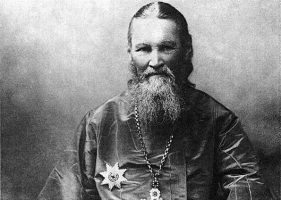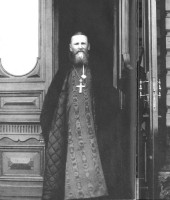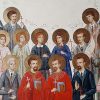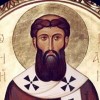Remember your leaders, those who spoke to you the word of God, consider the outcome of their lives and imitate their faith… (Hebrews 13:7)
As we reflect on the Lives of the Saints and seek to imitate their faith, one of the challenges, especially for we priests, is that the vast majority of Orthodox saints were either martyrs who suffered and died for Christ or were monks and nuns. Very few of our canonized Saints were married men and women who raised families, and even fewer were married priests. How can I, as a priest, lead a holy, Christ-centered life since I have a wife and a family and cannot spend hours each day in daily prayer nor undertake feats of asceticism as many of the saints? One great exception is St. John of Kronstadt, a married Russian priest, who with the exception of St. John Chrysostom, is probably the most popular saint among Orthodox priests.
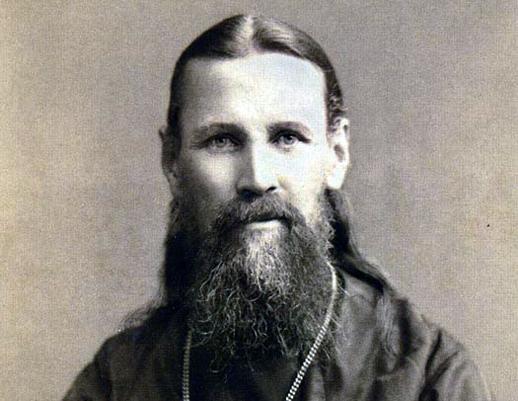
Father John of Kronstadt was born in 1829 in the north of Russia to pious parents, his father Elias the sacristan at the village church. While completing his seminary studies at the St. Petersburg Academy he dreamt of becoming a missionary to the natives of Siberia or Alaska but observing the conditions of society in St. Petersburg he realized that there was much missionary work needed in Russia. He suffered from a long period of depression while at the Academy and later said he was only freed from this darkness by long prayer. As he struggled over which direction to take in life he had a dream in which he saw himself as a priest at St. Andrew’s Cathedral in the city of Kronstadt, which is near St. Petersburg. Graduating from the Academy, he married Elizabeth, the daughter of a priest and was ordained a priest in 1855. Appointed to St. Andrew’s Cathedral in Kronstadt, he was deeply moved when he entered the church for the first time and realized it was the church he had seen in his dream. His relationship to Elizabeth was more the relationship between a brother and sister since he devoted himself to virginity.
The city of Kronstadt was the place to which criminals from St. Petersburg were routinely deported and as a port city it was teeming with sailors, unskilled workers working the docks and crowds of homeless people living in shacks and dugouts around the city. It was among these people that Father John began his ministry. Knowing of his generosity, crowds of beggars would flock outside his home and church and became known as Father John’s regiment. Father John at first gave money and food to all who came to him but soon realized this was only temporary help and sometimes harmful to the poor. In 1873 he opened a House of Industry consisting of a number of workshops, a dormitory, a dining area, a health clinic, library, and an elementary school. Here the poor were not simply given hand-outs but were helped to rise out of their poverty by learning a trade and receiving an education.
Serving as the pastor of a large city parish, serving the needs of the poor who flocked around him, teaching religion in the local schools had Father John working from early morning to late evening each day. In the midst of his exhausting ministry he devoted careful time to his inner life of prayer and kept a diary in which he set down his thoughts, feelings, and prayers. This diary has been published in English under the title My Life in Christ and reveals the source of Father John’s strength to endure the many demands on him. For Father John, the center of his life was celebrating the Liturgy and receiving the Lord in Holy Communion, which he did daily. He wrote in his diary:
I die when I am not celebrating the Liturgy…
There is no true life in us without the Source of Life – Jesus Christ. The Liturgy is the source of true life, because God Himself is in it; The Lord of life gives Himself as food and drink to the believers, gives to His communicants life in abundance, as He himself says: ‘He who eats my flesh and drinks my blood has eternal life’. (John 6:54)
One person who observed Father John celebrating a Divine Liturgy wrote his impressions:
After having celebrated the Divine Liturgy and received Holy Communion, Father John’s face has changed. No longer is there in it even a trace of that fatigue and any kind of grief or sorrow which could have been seen when he first entered the church. An extraordinary spiritual joy, extraordinary peace and heavenly rest, extraordinary strength and power were now reflected in each trace of his features. His face was as if glowing, was as if giving off some sort of light. Father John was ready to once again work without tiring from morning to middle of night, he had supplied himself with a store of strength for all the daily tasks and worries which lay before him.
Father John’s devotion to the Holy Eucharist led him to encourage frequent reception of the Holy Mysteries among his people, as unusual practice at the time since for most Russians Holy Confession and Holy Communion were done once a year as merely an obligation. He expressed his dismay at such attitudes:
How meagerly you take Communion, and how necessary it is to partake more frequently! Your soul is parched with hunger and thirst for grace. Think of the Samaritan woman and Jesus Christ and know how to seek the living water of grace.
Father John also devoted much time and energy to renewing the Sacrament of Holy Confession, which at that time had also become reduced to a once a year formality. He spent hours in individual confessions, writing in 1859
What a wonderful thing! I heard people’s confessions yesterday from 4 to 11 p.m., and even though I was a little tired, I went to bed a midnight, and having gotten up at 4:30 a.m., felt brisk and healthy! How good it is to work for the Lord! How He strengthens one – it is marvelous!
One penitent recorded his memories of confession with Father John:
He was not content with a simple, formal confession, but embarked on an entire education, testing, and examination of the feelings of the soul and of the penitent’s religious knowledge. Sometimes he would spend hours with the penitent and, postponing the absolution, made him return again and again. As the years went by the number of penitents grew tremendously.
By the 1890’s so many people flocked to him for Confession that Father John instituted the radical practice of group, public confessions. Accounts of those mass confessions speak of thousands of people crowded into the Cathedral around Father John who weeping would speak to the people and lead the prayers of Confession. The crowd of penitents too would be weeping, screaming, shouting out their sins in repentance, falling prostrate on the floor. It is recorded that such public Confessions would go on for two or more hours.
Also by 1890 Father John had acquired a reputation throughout Russia not only as a holy, generous priest but as a miracle worker. In 1883 sixteen people published a letter in a local newspaper thanking God for their healings through the prayers of Father John. From that time on, thousands of the sick and suffering descended on Kronstadt seeking his help in their healing.
In his diary and letters that have been preserved, Father John reveals that all in his life was not successful and all were not supportive of his ministry. He speaks of conflicts with his Metropolitan Isidor and the church hierarchy who were suspicious and cautious of his spreading celebrity. He also wrote of jealousy and envy on the part of fellow clergy who were reluctant to allow him to serve in their churches and disagreements with his wife who resented the women who demanded his attention. Predicting the calamity of the coming Russian Revolution of 1917, he was resented by many of the intelligentsia for his increasing number of sermons which warned Russia of a coming terrible judgment of God and the need for repentance.
Father John’s health began to decline in 1906 but he continued to celebrate his daily Divine Liturgy until December 10, 1908. He fell asleep in the Lord on December 20, 1908 having received the Lord in Holy Communion till his last day. Father John was buried in the woman’s monastery he had founded in St. Petersburg after a massive, public funeral. He was officially glorified as a saint by the Orthodox Church in Russia in 1988. This writer had the blessing, several years ago, of visiting the tomb of St. John in St. Petersburg, located in a basement chapel of the convent he founded. The nuns of the monastery informed me that Father John’s relics are not in the tomb but were hidden from the Communists during the Revolution and their location is unknown. The nun added: We know his body is somewhere nearby, we feel his presence and miracles still take place here.
Source: The American Carpatho-Russian Orthodox Diocese of the U.S.A.












